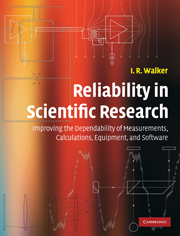 Reliability in Scientific Research
Reliability in Scientific Research Book contents
- Frontmatter
- Contents
- Preface
- List of abbreviations
- 1 Basic principles of reliability, human error, and other general issues
- 2 Mathematical calculations
- 3 Basic issues concerning hardware systems
- 4 Obtaining items from commercial sources
- 5 General points regarding the design and construction of apparatus
- 6 Vacuum-system leaks and related problems
- 7 Vacuum pumps and gauges, and other vacuum-system concerns
- 8 Mechanical devices and systems
- 9 Cryogenic systems
- 10 Visible and near-visible optics
- 11 Electronic systems
- 12 Interconnecting, wiring, and cabling for electronics
- 13 Computer hardware and software, and stored information
- 14 Experimental method
- Index
- References
1 - Basic principles of reliability, human error, and other general issues
Published online by Cambridge University Press: 05 June 2012
- Frontmatter
- Contents
- Preface
- List of abbreviations
- 1 Basic principles of reliability, human error, and other general issues
- 2 Mathematical calculations
- 3 Basic issues concerning hardware systems
- 4 Obtaining items from commercial sources
- 5 General points regarding the design and construction of apparatus
- 6 Vacuum-system leaks and related problems
- 7 Vacuum pumps and gauges, and other vacuum-system concerns
- 8 Mechanical devices and systems
- 9 Cryogenic systems
- 10 Visible and near-visible optics
- 11 Electronic systems
- 12 Interconnecting, wiring, and cabling for electronics
- 13 Computer hardware and software, and stored information
- 14 Experimental method
- Index
- References
Summary
Introduction
A number of basic qualities or conditions are of value whenever reliability is an issue. These include: (a) simplicity, (b) redundancy (providing duplicate or backup components or systems), (c) margins of safety, (d) modularity (dividing complicated things into simple components), and (e) conservatism (using conservative technology). These factors, and others, are considered in the following chapter.
Human error is, of course, a very important cause of problems in all activities. It might be thought that little can be done to prevent such errors, but this is far from the case. For example, numerous investigations have been carried out (mostly in the aviation and nuclear industries), which show that errors are generally not completely random and unpredictable events, but usually follow regular patterns. These results, which are discussed below, suggest ways of avoiding errors, or at least mitigating their consequences.
Other sections of the chapter discuss record keeping in the laboratory (the lack of which is a common cause of problems), the maintenance and calibration of equipment, and general strategies for troubleshooting apparatus and software.
Central points
The following are very general principles of reliability that recur repeatedly in all activities in research.
- Type
- Chapter
- Information
- Reliability in Scientific ResearchImproving the Dependability of Measurements, Calculations, Equipment, and Software, pp. 1 - 35Publisher: Cambridge University PressPrint publication year: 2011


